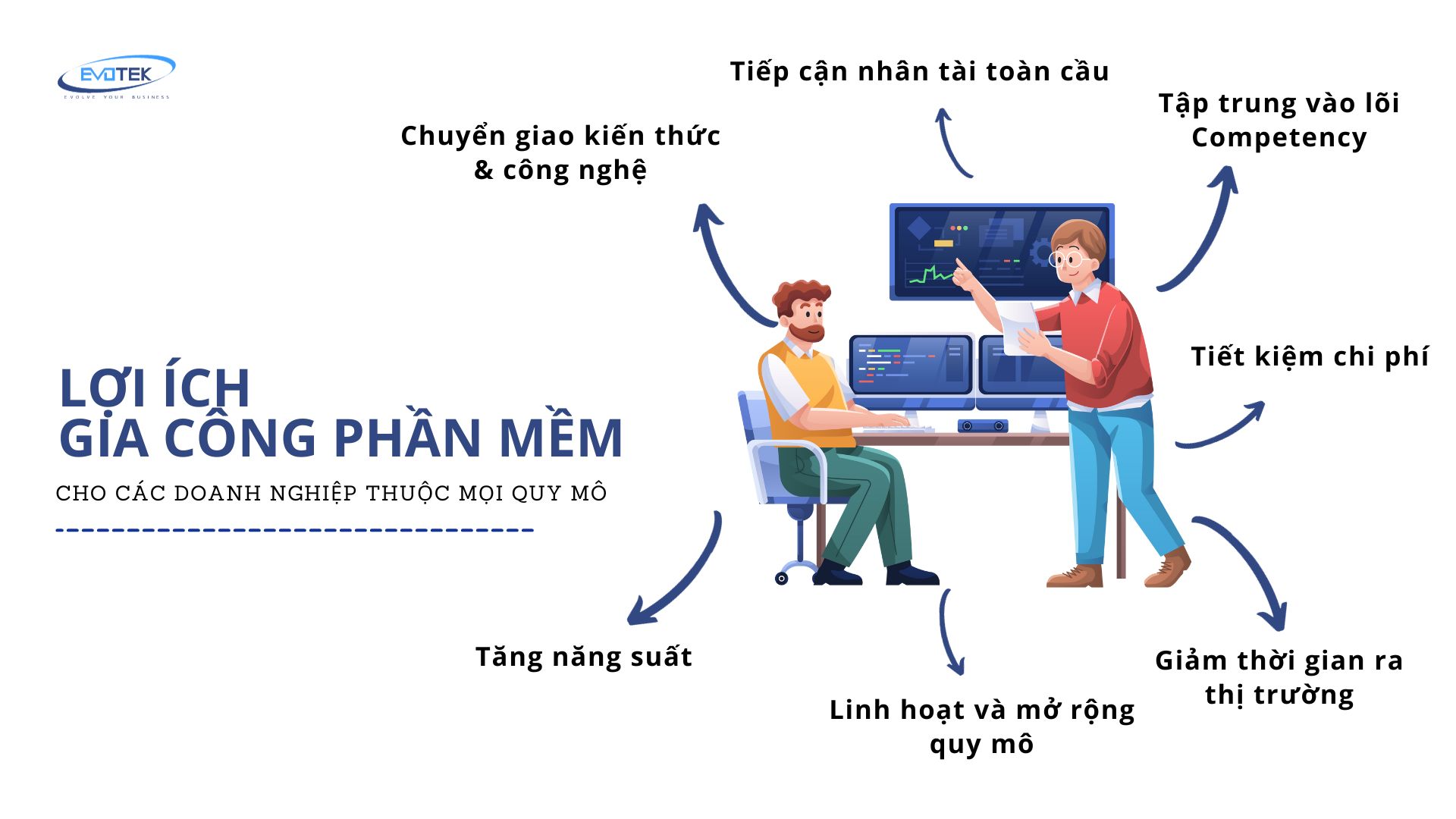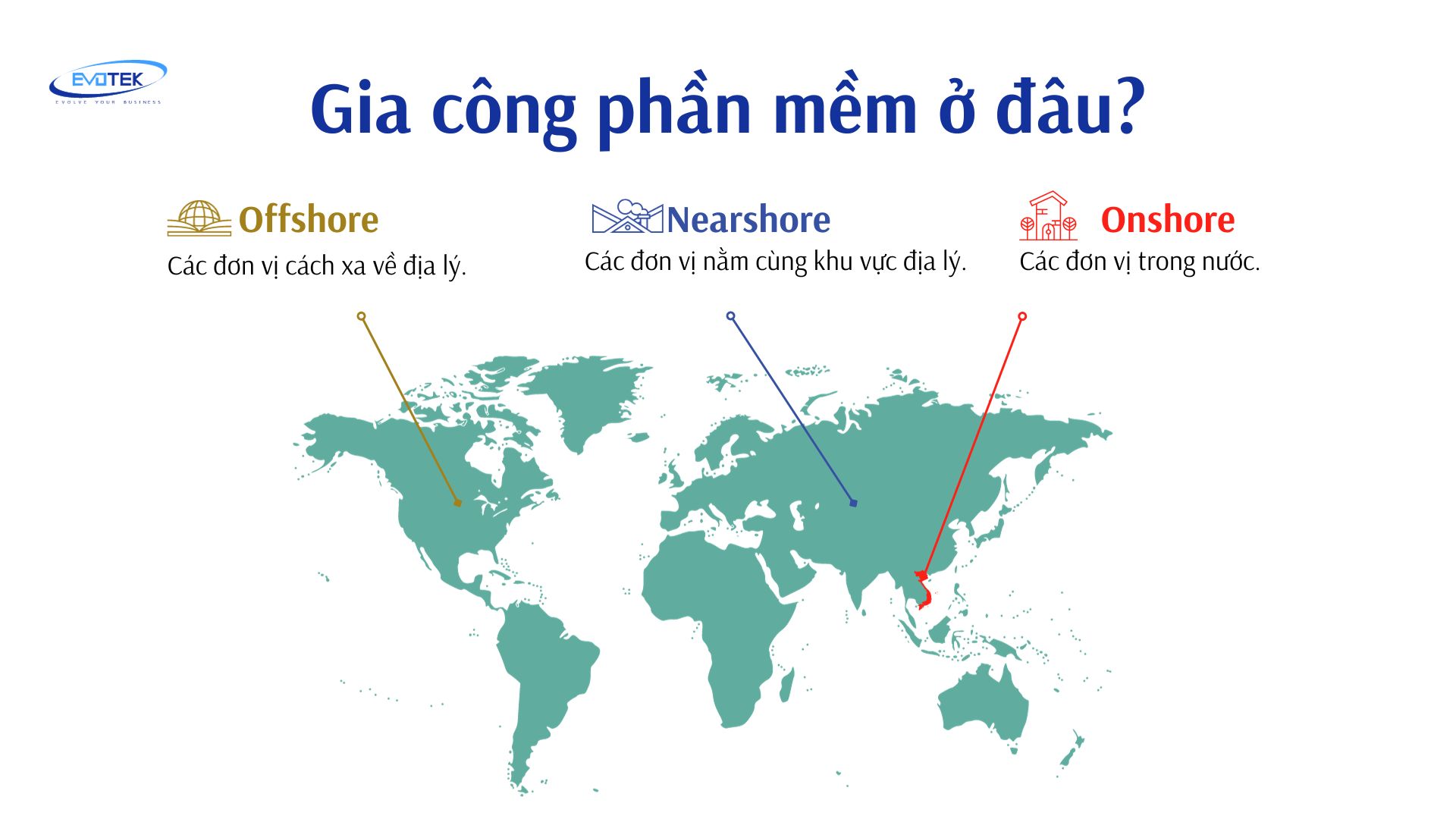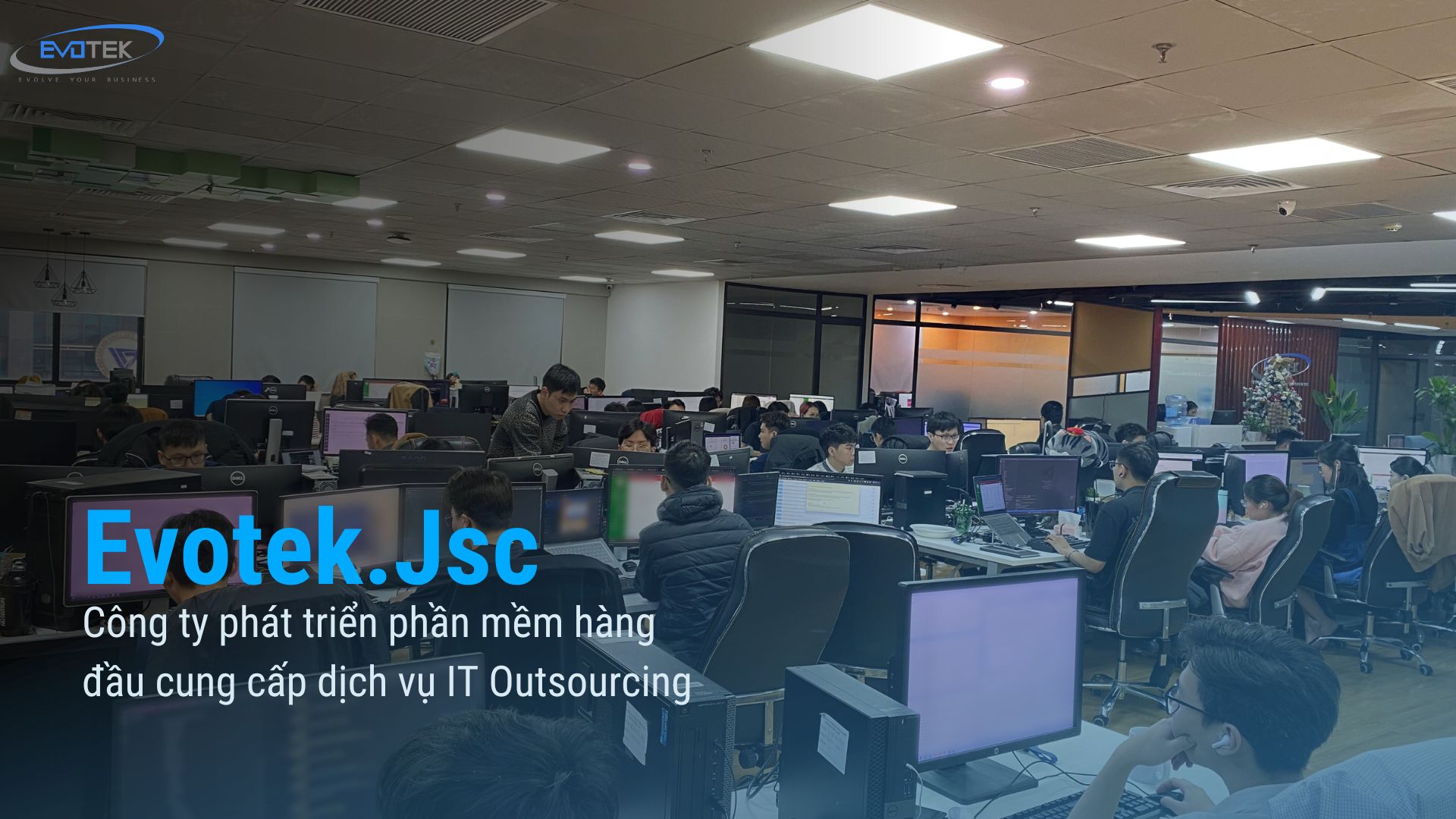Outsourcing can bring many benefits to businesses of all sizes
What is Software Outsourcing?
Outsourcing (Software outsourcing) refers to the practice wherein businesses engage third-party service providers to develop technology solutions and software products tailored to their needs, instead of establishing an in-house software development team.
This approach enables companies to access skilled programming talent globally at a reduced cost compared to assembling an internal team.
Businesses can outsource various phases of the software development lifecycle, including programming, testing, maintenance, consulting, and project management. By doing so, organizations can allocate their resources more efficiently, focusing on core business activities while retaining ownership of the product. Selecting a reputable software outsource service provider with the requisite technical expertise and corporate culture is crucial for fostering long-term partnerships.
Consequently, software outsourcing offers numerous benefits, including access to abundant, high-quality human resources at lower costs compared to maintaining internal teams. It represents an indispensable trend that empowers businesses to remain agile and optimize resource utilization.
Benefits of outsourcing

1. Cost Savings
- Outsourcing human resources to countries like India and Vietnam can save 50-70% on labor costs compared to development in the US/Europe.
- Reduce costs associated with infrastructure investment, recruitment, personnel training, etc., by leveraging the available resources of the contractor.
- Convert fixed costs to variable costs, paying only for utilized services.
2. Focus on Core Competency
- Outsourcing is beneficial for young companies lacking experience in product implementation.
- Companies can concentrate their available capacity on core business activities instead of dispersing it on IT development.
3. Access to Global Talent:
- Software outsourcing service providers often maintain a rich talent pool with specialized skills in software technology, project management, , artificial intelligence, , data analysis, , user experience design,etc. Companies can augment their internal teams with resources from foreign markets to build a strong software development team.
- Flexibility in recruiting or downsizing personnel as needed.
4. Increased Productivity:
- Software contractors leverage their expertise to establish optimal development processes, resulting in quick and effective project delivery.
- Ability to manage multiple projects simultaneously to expedite product development.
5. Flexibility and Scalability:
- Easily adjust the size of the technical team according to project requirements, without being constrained by internal capacity.
- Savings in time and costs compared to recruiting and training new personnel.
- Ideal for projects with fluctuating human resource demands based on periods or seasons.
6. Reduced Time to Market:
- Concurrent development of multiple features reduces waiting time.
- Advantageous time zone differences allow for 24/7 development to maximize lead time.
- Enhanced labor productivity compared to internal teams due to specialization.
7. Knowledge and Technology Transfer:
- Gain insights from partners’ experiences in managing and developing software projects.
- Stay abreast of new technologies being applied in the global market.
- Improve skills of internal human resources through collaborative efforts.
Outsourcing software development offers cost-effectiveness, access to specialized skills, faster product cycles, and the sharing of best practices, empowering companies to compete robustly in the digital economy.
How to choose a software outsourcing partner

In the rapidly growing landscape of software outsourcing, the selection of the right software outsourcing provider plays a pivotal role in determining the outcome of each project. Administrators embarking on this journey must begin by clearly defining the skill sets and technological requirements essential for their projects. Priority should be accorded to units boasting extensive experience and a stellar reputation in the industry.
Technical prowess and robust development processes are paramount considerations, underpinned by a team of highly skilled professionals. Equally crucial is identifying a partner whose culture and vision align with the company’s, fostering a collaborative environment conducive to effective communication and synergy. Transparent pricing models and clear contractual terms further bolster trust and transparency in the partnership.
In essence, through a comprehensive evaluation encompassing capacity, human resources, and financial considerations, businesses can identify an exceptional software outsourcing partner. This sets the stage for sustainable collaboration and remarkable success.
Where to outsource software? Choosing a nearshore, offshore or onshore partner?

When seeking a software development supplier, businesses often encounter the decision of selecting from three prevalent forms of service: nearshore outsourcing, offshore outsourcing, and onshore outsourcing. Each type offers distinct advantages depending on the specific circumstances and objectives of the business.
Nearshore outsourcing entails collaboration with units located in close geographical proximity, typically within a few flight hours. European companies, for instance, may opt to outsource to partners in Eastern Europe to realize cost savings while maintaining cultural and linguistic proximity. This option is deemed optimal in terms of cost-effectiveness, ensuring alignment with key elements of the software development process.
Offshore outsourcing involves partnering with geographically distant units, often concentrated in Asian countries such as India, Vietnam, and the Philippines, offering significantly lower labor costs. Consequently, American and European companies frequently prioritize this approach to achieve maximum cost savings. However, it presents challenges related to cultural disparities, language barriers, and difficulties in management and supervision.
Onshore outsourcing, or domestic outsourcing, remains the preferred choice for many large corporations and companies despite higher initial investment costs. The seamless alignment in language and business culture makes collaboration with domestic partners more convenient and efficient. Additionally, communication, collaboration, and project monitoring become significantly easier.
Thus, businesses select the appropriate type of software outsourcing based on economic conditions, human resources, and specific objectives. However, the prevailing trend involves combining multiple types to leverage the advantages and mitigate the disadvantages of each option, thereby enhancing operational efficiency and competitiveness.
Effective software development outsourcing process

1. Define Project Goals
Clearly outline specific goals for the project and collaborate with stakeholders, including leaders, users, and customers, to gather input and insights.
2. Develop a Strategy
Identify all project stakeholders and their respective roles, ensuring clear communication channels and information flow throughout the project lifecycle.
3. Document Scope of Work
Create comprehensive documentation outlining project scope, including budget constraints and specific requirements, to be shared with the chosen software partner.
4. Select Technology Stack
Compile a list of required technologies and security considerations for the project, ensuring compatibility with the capabilities of the chosen software partner.
5. Assemble Technical Team
Appoint an experienced project leader and assemble a proficient technical team to ensure project success and maintain quality standards.
6. Choose Outsourcing Provider
Select a reputable and reliable software outsourcing provider with a proven track record and a skilled technical workforce.
7. Manage Scope, Budget, and Timeline
Implement an agile project management approach to effectively monitor and control project scope, budget, and timelines, ensuring alignment with project objectives.
By following these steps, you can establish a streamlined and efficient outsourced software development process, ultimately leading to successful project outcomes.
Software outsourcing contract models
Software development outsourcing models are characterized by the relationship and level of involvement between the customer and the service provider. Below are typical software development outsourcing contract models:
Fixed Price Model:
This model entails agreement upon a predetermined project scope, timeline, and budget, with the outsourcing provider undertaking to deliver the project within these parameters. It is well-suited for projects with clearly delineated scopes and deliverables.
Advantages
- Provides a clear and predictable budget for the project.
- Project scope and deliverables are clearly defined.
- Low risk for customers as prices are fixed.
Disadvantages
- Less flexibility in adjusting scope or requirements within the project.
- Outsourcing service providers are incentivized to expedite project completion to maximize profits.
Time and Material Flexible Model
This model proves apt for complex projects or scenarios where requirements and scope are not clearly delineated from the outset. Outsourcing service providers receive compensation based on time and resources expended, inclusive of material and equipment costs. Customers typically remit payments at regular intervals—monthly or biweekly—for completed work.
Advantages
- Flexibility in adjusting scope and requirements.
- Encourages more efficient project completion.
- Provides a transparent view of costs and progress
Disadvantages
- Challenging to accurately estimate total project costs from inception.
- Customers bear the brunt of cost risks.

Dedicated Team Model
Under this model, a dedicated team of software developers, testers, and project managers is enlisted to work intensively on the project for a specified duration. It proves beneficial for long-term or intricate projects necessitating close collaboration and communication between the customer and the outsourcing entity.
Advantages
- High degree of collaboration and communication.
- Customers exercise full control over the project and team.
- The outsourcing entity is committed to project success.
Disadvantages
- Demands substantial commitment from the customer in terms of time and resources.
Human Resources Augmentation Model
This model entails hiring additional employees—software engineers or testers—from an outsourcing company to collaborate with the internal team. These employees are typically highly skilled, experienced, and participate in projects for short durations—typically spanning weeks or months.
Advantages
- Flexibility in participation duration and scope of work.
- May yield cost savings vis-à-vis hiring full-time employees.
- Facilitates rapid team scaling with highly skilled personnel.
Disadvantages
- Integration with internal teams may prove challenging.
- Customers need to invest time and resources in training outsourced personnel.
Build–Operate–Transfer Model
Under this model, the supplier constructs, manages, and operates a professional team, subsequently transferring ownership to the customer.
Advantages
- Provides a low-risk avenue for customers to establish a dedicated long-term team.
- The outsourcing entity is tasked with managing the team, infrastructure, and resources.
- Customers ultimately assume ownership of the team.
Disadvantages
- Cost is higher compared to other outsourcing models.
- Requires substantial long-term commitment from both parties.
- Each model proffers distinct benefits and drawbacks, with the choice contingent upon specific project requisites and business objectives.
For Successful Software Outsourcing Project Management
Effective management of a software outsourcing project demands meticulous preparation and a robust strategic approach. Key components include defining precise project goals, formulating a comprehensive outsourcing strategy, and crafting a detailed scope of work document. Additionally, identifying the appropriate technology stack, appointing an experienced technical lead, and exercising stringent control over project scope, budget, and timeline are pivotal. Facilitating open communication channels and conducting regular meetings are essential to fostering alignment among stakeholders, mitigating risks, and attaining project objectives.
Security and intellectual property rights in software outsourcing
Addressing security and safeguarding intellectual property rights are paramount considerations in the realm of software outsourcing, particularly amidst the dynamic landscape of the Information Technology industry.
These aspects represent significant challenges and strategic imperatives crucial for the successful execution of projects. The exchange of sensitive data and proprietary source code necessitates stringent safeguards, demanding unwavering assurance from partnering entities. Adherence to established security standards, coupled with regular system evaluations and updates, is imperative to combat evolving security threats effectively.
Navigating the intricacies of managing intellectual property rights during the software outsourcing process presents a multifaceted challenge The dissemination of technology and specialized knowledge inherently raises complexities in IP rights management. Contracts and agreements must delineate ownership arrangements meticulously to preclude potential conflicts and legal disputes.
Effective strategies in this domain encompass selecting a reputable and trustworthy security partner, crafting comprehensive security and IP contracts, and implementing access controls to restrict source code and information solely to pertinent stakeholders.Additionally, employing protective measures such as encryption further fortifies the safeguarding of proprietary source code.
Quality control of software outsourcing products
The quality control of software outsourcing products stands as a pivotal process aimed at ensuring alignment with the stringent quality standards of the business.
Commencing with the establishment of precise quality benchmarks, the process entails the thorough application of testing methodologies to meticulously scrutinize every facet of the product.
Performance oversight, leveraging automated testing technologies, and the establishment of a conducive test environment are pivotal in optimizing the quality control regimen. Sustained communication channels facilitating continuous feedback between the development and testing teams, coupled with periodic performance evaluations of the development team, foster consistency and excellence throughout the product development lifecycle Moreover, the implementation of robust quality risk management protocols and unwavering adherence to quality control procedures serve as pivotal measures in mitigating risks and upholding elevated quality standards.
EVOTEK – A Trusted Partner for Software Development Outsourcing Services
EVOTEK emerges as a premier software development company specializing in IT outsourcing. Established in 2018, EVOTEK prides itself on being a trusted partner to over 300 domestic and international enterprises.
Backed by a team of seasoned programmers, EVOTEK offers an array of services, encompassing on-demand software development, mobile application development, website design, training, and technology transfer, effectively addressing all customer IT outsourcing requirements.
Adhering to the Agile model, EVOTEK is committed to delivering high-quality software products to customers, ensuring progress and economic efficiency. Furthermore, a stringent information security policy stands as a cornerstone of EVOTEK’s capabilities.







